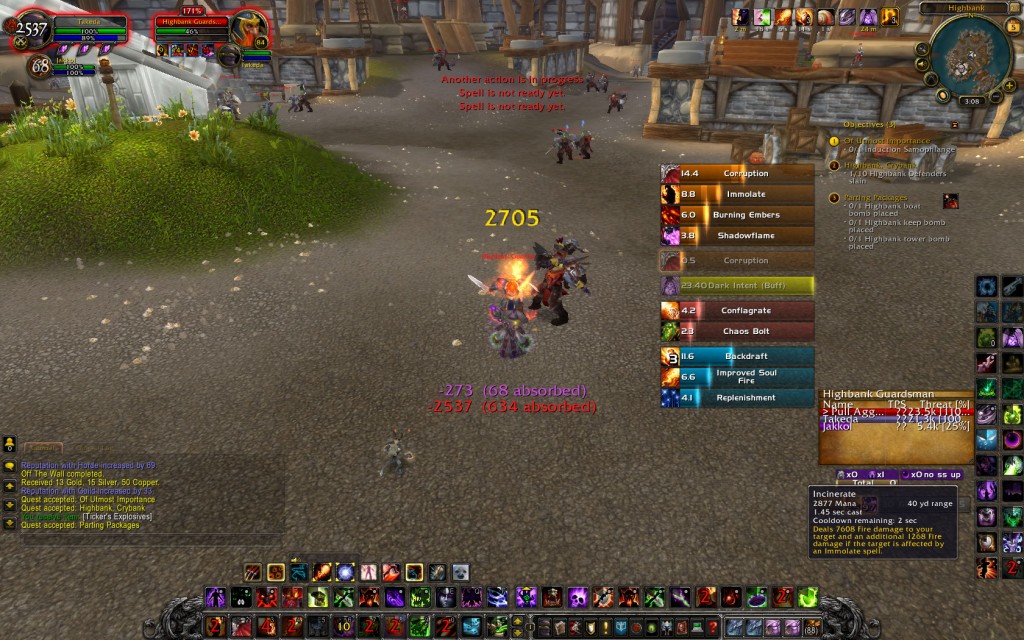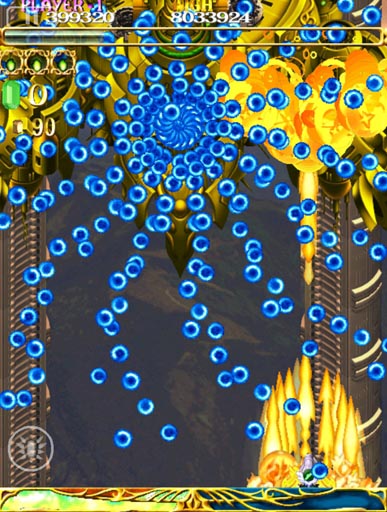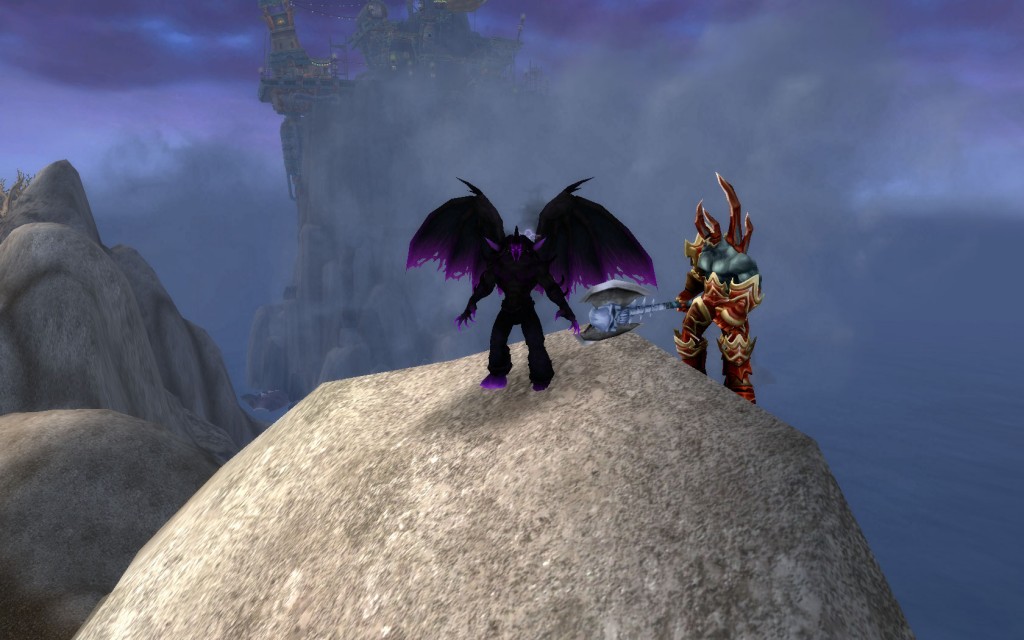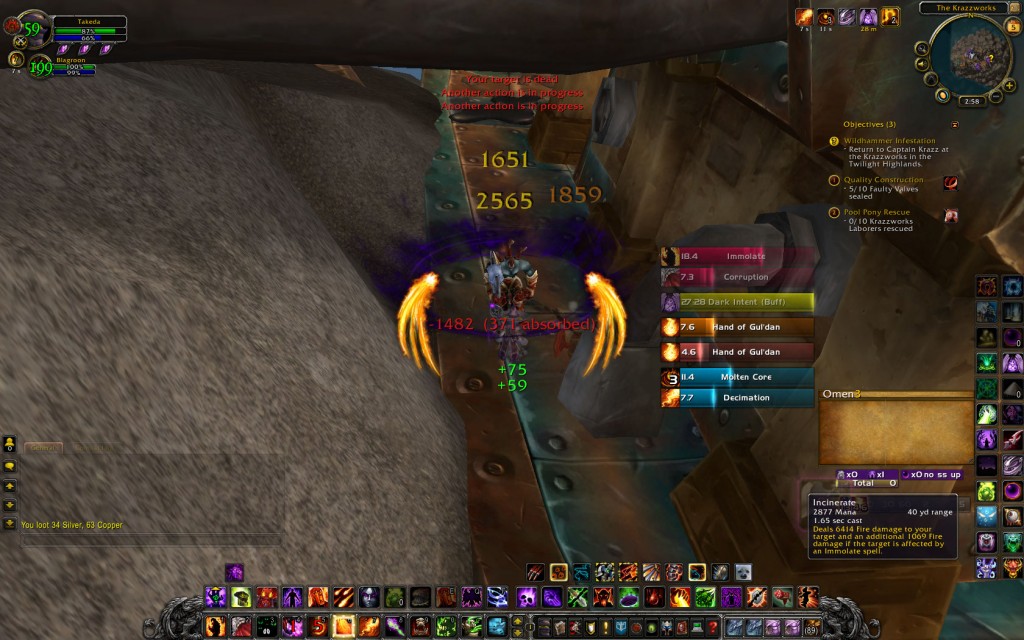Last updated on March 3, 2013
I’ve been reading Cynwise’s The Decline and Fall of Warlocks in Cataclysm; it’s a gigantic set of posts, almost like a tiny book (and even released as such at its end). Still, it’s pretty fascinating to read for a few reasons:
- It shows how Warlocks, In WoW’s most recent expansion, have experienced a downturn; not only are they the least played class, there are many possible causes that all contribute to this problem.
- First, Warlocks have increased in complexity, but not in reward. While other classes, such as Paladins, Druids, and Mages have gotten increased buff to their damage output and a variety of different ways to achieve that end, Warlocks have only gotten more abilities added to their traditional damage output. As such, the class has become less interesting mechanically and aesthetically.
- As Warlocks work primarily with Damage Over Time abilities, or DoTs, the game makes you keep track of them for maximum DPS, or Damage per Second, to have Warlocks succeed. However, what occurs is that their rotations (a set of abilities used by a class in specific priority or order) add unneeded complexity without any further reward. Certain talent specs had 19 buttons to use; that is crazy by any standard, and probably any game I can imagine.
- As well, Warlock talent specializations do not actually fit with the intended motive for that spec. Demonology, for example, has more nukes and bolts than Destruction, which is supposedly designed as the nuke spec for Warlocks. Destruction has the most DoTs, which is supposedly Affliction’s specialty. Affliction seems relatively fine, but it still requires a mechanic called “demon-twisting”; as a “pet class”, warlocks have pets, but they have to summon new pets in combat (unlike, say, hunters). It’s clunky and weird, and not at all like any other class for the same damage output. Literally, the whole set is messed up.
- Furthermore, talents on the three trees are difficult to pick out for any new players, mostly because many of the talents refer to abilities a player will not receive until 50-60 levels later. Thus, it’s difficult for anyone to actually choose correctly on their first try. As such, this barrier to entry has prevented warlocks from gaining any popularity or retaining players at the early levels of the game, which are the most important for player retention. Usually, other classes are chosen instead.
- Thus, at end-game raiding, the complexity should provide additional DPS, but Warlocks specs are solidly at the middle of the pack even as they specialize in damage. Other specs, even those of hybrid class, dominate them in any PvE environment.
In the end, it comes down to a question of accessibility: Warlocks aren’t accessible at all. Not only are they too complex to play at end-game, but leveling a warlock becomes an exercise in frustration because of that complexity. Thus, those who keep playing Warlocks are unhappy and leaving their class, and new players aren’t picking warlock because it doesn’t make sense, and isn’t fun. Then, all that complexity yields little reward; a hunter in blues could do as much damage as a warlock in epics, and that is simply unacceptable. Anyone optimizing their choice of class would do well to avoid warlocks at all costs.
To illustrate:
See the addon on the right of the screen? That is showing the cooldown on my abilities. Immolate and Corruption are DoTs on the target, while Hand of Gul’dan needs to be cast on cooldown. You cast Incinerate three times if Molten Core procs. You also have to keep Decimation up by casting Soulfire. If the enemy lives longer than 60 seconds, use Bane of Doom. If Shadow Bolt glyph procs, use the free instant cast Shadowbolt. If nothing else is available, use Incinerate as filler or Shadowbolts in Area of Effect (multiple target) situations. That’s not even getting into using Metamorphosis, which you must use all cooldowns first (such as Demon Soul, trinket procs, anything that could randomly happen) then pop it, then go into melee range, use Hellfire Aura, pop either Summon Doomguard or Infernal (former for single target, latter for AoE), then proceed with the pattern.
Phew! That’s a lot of stuff to understand, memorize, and know at a moment’s notice, at the same time as you’re trying not to kill your group by accident or die.
Destruction, as stated earlier, is even more complicated:

Honestly? Not going to get into this one. I’m honestly going to say I don’t like it that much. About 4 DoTs to track, along with a few timed self-buffs, is just too much for me.
I say this because I had always wanted to play a warlock. They just look so cool, and the idea of a sturdy magic class that acts like a vampire, or transforms into a demon, or uses fire like a pyromaniac are simply fun ideas right from the get-go. Take a look at how cool the gear looks. There’s no way someone can say they don’t look anything other than awesome, unless you are equally uncool. The MMO class choosing process, in this case, was mostly a view at aesthetics; mostly, I don’t like casters, but this was an exception.
Now, for a person like me who has been playing World of Warcraft a bit too long, even the leveling process for my Warlock Takeda was rather arduous. I play melee DPS and tanking classes for the most part, but I always loved how powerful Warlocks were in PvE and PvP. A caster seemed the right idea at the time, seeing as I never really played a dedicated DPS class, so I made the leap. However, I definitely experienced every single problem Cynwise listed above, especially the talent tree and learning to play. There’s a large difference between, say, looking at ElitistJerks for rotation and spec information and learning yourself. I chose the former path, only because I am obviously familiar with the game.
Now, to ask, should a game be accessible? A lot of people say that game X isn’t fun simply because it isn’t approachable. Any number of Cave shooters, such as Espgaluda II, are not accessible and have huge difficulty curves – in fact, that has become the hallmark of the genre in recent years, with bullets filling the screen requiring minute adjustments to survive. However, that does not hamper Cave games from being any fun – it takes time to learn the scoring system and enemy patterns, but to play without dying and play to perfection is the point of the experience.

That’s not to say an MMORPG like WoW should actually function in the same capacity. Most Blizzard games follow the adage “easy to learn, difficult to master’, but should every game give that same experience? There is a place for complex rule-sets as well as the simplest of games. The modern trend sees developer slapping every single game with a tutorial of some kind, even those that don’t need such a device, yet the appeal to the lowest common denominator at all times gets on my nerves. For a first person shooter, for example, I do not need a tutorial, yet the game incessantly reminds me what buttons to push when. When did the instruction manual become such a dying breed?
Sometimes, part of the fun is discovering what works and what does not – the optimal strategy for success in any games doesn’t need to be apparent outright. As in entertainment, so as in life, part of the experience is a process of learning. An instantaneous victory, as many modern games provide, give absolutely no sense of fulfillment. It’s similar to the idea of sanctification in, specifically, Methodist theology, wherein salvation is the beginning point for the believer, never an end. Hebrews 12:7, for example, states “It is for discipline that you endure; God deals with you as with sons; for what son is there whom his father does not discipline?” Furthermore, in Hebrew 12:12-14, “Therefore, strengthen the hands that are weak and the knees that are feeble, and make straight paths for your feet, so that the limb which is lame may not be put out of joint, but rather be healed. Pursue peace with all men, and the sanctification without which no one will see the Lord.”
Why not with video games too? Why does everything have to be instantaneous in the video game world? This seems entirely a negative trend. A video game certainly shouldn’t feel like a job you hate, but it certainly shouldn’t feel effortless unless you’ve taken the time and effort to truly learn how to play well. That’s how all these game communities sprung up, after all; see Shoryuken, a site totally devoted to fighting games, which for years had little to no tutorials teaching anyone how to play them well! It was only through a socialization process that those games even became what they are, and even developers are starting to cater to their discoveries and their community.
What I’m really trying to say is that I really like playing my warlock, even if it’s broken and weird and messy as a class, because I like the complexity for complexity’s sake. Video games have moved from my masochistic tendencies, I imagine, but they can never remove challenge completely. A game too accessible loses its luster far too quickly – I’d rather have something intorably difficult than something too easy, market forces be darned.


